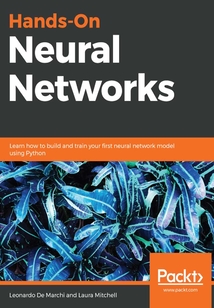舉報 

會員
Hands-On Neural Networks
Neuralnetworksplayaveryimportantroleindeeplearningandartificialintelligence(AI),withapplicationsinawidevarietyofdomains,rightfrommedicaldiagnosis,tofinancialforecasting,andevenmachinediagnostics.Hands-OnNeuralNetworksisdesignedtoguideyouthroughlearningaboutneuralnetworksinapracticalway.Thebookwillgetyoustartedbygivingyouabriefintroductiontoperceptronnetworks.YouwillthengaininsightsintomachinelearningandalsounderstandwhatthefutureofAIcouldlooklike.Next,youwillstudyhowembeddingscanbeusedtoprocesstextualdataandtheroleoflongshort-termmemorynetworks(LSTMs)inhelpingyousolvecommonnaturallanguageprocessing(NLP)problems.Thelaterchapterswilldemonstratehowyoucanimplementadvancedconceptsincludingtransferlearning,generativeadversarialnetworks(GANs),autoencoders,andreinforcementlearning.Finally,youcanlookforwardtofurthercontentonthelatestadvancementsinthefieldofneuralnetworks.Bytheendofthisbook,youwillhavetheskillsyouneedtobuild,train,andoptimizeyourownneuralnetworkmodelthatcanbeusedtoprovidepredictablesolutions.
目錄(211章)
倒序
- coverpage
- Title Page
- Copyright and Credits
- Hands-On Neural Networks
- Dedication
- About Packt
- Why subscribe?
- Packt.com
- Contributors
- About the authors
- About the reviewers
- Packt is searching for authors like you
- Preface
- Who this book is for
- What this book covers
- To get the most out of this book
- Download the example code files
- Download the color images
- Conventions used
- Get in touch
- Reviews
- Section 1: Getting Started
- Getting Started with Supervised Learning
- History of AI
- An overview of machine learning
- Supervised learning
- Unsupervised learning
- Semi-supervised learning
- Reinforcement learning
- Environment setup
- Understanding virtual environments
- Anaconda
- Docker
- Supervised learning in practice with Python
- Data cleaning
- Feature engineering
- How deep learning performs feature engineering
- Feature scaling
- Feature engineering in Keras
- Supervised learning algorithms
- Metrics
- Regression metrics
- Classification metrics
- Evaluating the model
- TensorBoard
- Summary
- Neural Network Fundamentals
- The perceptron
- Implementing a perceptron
- Keras
- Implementing perceptron in Keras
- Feedforward neural networks
- Introducing backpropagation
- Activation functions
- Sigmoid
- Softmax
- Tanh
- ReLU
- Keras implementation
- The chain rule
- The XOR problem
- FFNN in Python from scratch
- FFNN Keras implementation
- TensorBoard
- TensorBoard on the XOR problem
- Summary
- Section 2: Deep Learning Applications
- Convolutional Neural Networks for Image Processing
- Understanding CNNs
- Input data
- Convolutional layers
- Pooling layers
- Stride
- Max pooling
- Zero padding
- Dropout layers
- Normalization layers
- Output layers
- CNNs in Keras
- Loading the data
- Creating the model
- Network configuration
- Keras for expression recognition
- Optimizing the network
- Summary
- Exploiting Text Embedding
- Machine learning for NLP
- Rule-based methods
- Understanding word embeddings
- Applications of words embeddings
- Word2vec
- Word embedding in Keras
- Pre-trained network
- GloVe
- Global matrix factorization
- Using the GloVe model
- Text classification with GloVe
- Summary
- Working with RNNs
- Understanding RNNs
- Theory behind CNNs
- Types of RNNs
- One-to-one
- One-to-many
- Many-to-many
- The same lag
- A different lag
- Loss functions
- Long Short-Term Memory
- LSTM architecture
- LSTMs in Keras
- PyTorch basics
- Time series prediction
- Summary
- Reusing Neural Networks with Transfer Learning
- Transfer learning theory
- Introducing multi-task learning
- Reusing other networks as feature extractors
- Implementing MTL
- Feature extraction
- Implementing TL in PyTorch
- Summary
- Section 3: Advanced Applications
- Working with Generative Algorithms
- Discriminative versus generative algorithms
- Understanding GANs
- Training GANs
- GAN challenges
- GAN variations and timelines
- Conditional GANs
- DCGAN
- ReLU versus Leaky ReLU
- DCGAN – a coded example
- Pix2Pix GAN
- StackGAN
- CycleGAN
- ProGAN
- StarGAN
- StarGAN discriminator objectives
- StarGAN generator functions
- BigGAN
- StyleGAN
- Style modules
- StyleGAN implementation
- Deepfakes
- RadialGAN
- Summary
- Further reading
- Implementing Autoencoders
- Overview of autoencoders
- Autoencoder applications
- Bottleneck and loss functions
- Standard types of autoencoder
- Undercomplete autoencoders
- Example
- Visualizing with TensorBoard
- Visualizing reconstructed images
- Multilayer autoencoders
- Example
- Convolutional autoencoders
- Example
- Sparse autoencoders
- Example
- Denoising autoencoders
- Example
- Contractive autoencoder
- Variational Autoencoders
- Training VAEs
- Example
- Summary
- Further reading
- Deep Belief Networks
- Overview of DBNs
- BBNs
- Predictive propagation
- Retrospective propagation
- RBMs
- RBM training
- Example – RBM recommender system
- Example – RBM recommender system using code
- DBN architecture
- Training DBNs
- Fine-tuning
- Datasets and libraries
- Example – supervised DBN classification
- Example – supervised DBN regression
- Example – unsupervised DBN classification
- Summary
- Further reading
- Reinforcement Learning
- Basic definitions
- Introducing Q-learning
- Learning objectives
- Policy optimization
- Methods of Q-learning
- Playing with OpenAI Gym
- The frozen lake problem
- Summary
- Whats Next?
- Summarizing the book
- Future of machine learning
- Artificial general intelligence
- Ethics in AI
- Interpretability
- Automation
- AI safety
- AI ethics
- Accountability
- Conclusions
- Other Books You May Enjoy
- Leave a review - let other readers know what you think 更新時間:2021-06-24 14:00:47
推薦閱讀
- Seven NoSQL Databases in a Week
- PowerShell 3.0 Advanced Administration Handbook
- PostgreSQL 11 Server Side Programming Quick Start Guide
- R Data Mining
- 錯覺:AI 如何通過數(shù)據(jù)挖掘誤導我們
- MCSA Windows Server 2016 Certification Guide:Exam 70-741
- Learning Apache Cassandra(Second Edition)
- Hands-On Machine Learning with TensorFlow.js
- 物聯(lián)網(wǎng)與云計算
- 讓每張照片都成為佳作的Photoshop后期技法
- 統(tǒng)計策略搜索強化學習方法及應用
- FPGA/CPLD應用技術(Verilog語言版)
- Apache源代碼全景分析(第1卷):體系結構與核心模塊
- 生物3D打印:從醫(yī)療輔具制造到細胞打印
- 和機器人一起進化
- MySQL Management and Administration with Navicat
- ARM體系結構與編程
- Mastering Machine Learning with R
- 互聯(lián)網(wǎng)單元測試及實踐
- 微計算機原理及應用
- ASP.NET 4.0 MVC敏捷開發(fā)給力起飛
- Deep Learning with PyTorch Quick Start Guide
- 亮劍.NET:圖解ASP.NET網(wǎng)站開發(fā)實戰(zhàn)
- OpenGL Development Cookbook
- ABB工業(yè)機器人虛擬仿真教程
- 仿魚機器人的設計與制作
- AutoCAD輔助繪圖百練成精
- Puppet 4.10 Beginner’s Guide(Second Edition)
- Microsoft Windows PowerShell 3.0 First Look
- Linux核心應用命令速查

